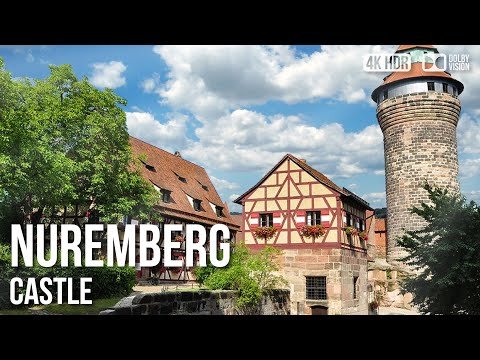🏰 Nuremberg Castle: Imperial History 🏰⚔️

Nuremberg Castle is a stunning fortress perched atop a hill in the heart of the city of Nuremberg, Germany. This magnificent castle dates back to the 11th century and has played a significant role in the history of the Holy Roman Empire. With its imposing walls, towers, and courtyards, Nuremberg Castle is a testament to the military might and imperial ambitions of the rulers who once called it home. In this article, we will delve into the rich history of Nuremberg Castle, from its early days as a medieval stronghold to its role in the trials of Nazi war criminals after World War II. Join us on a journey through time as we explore the fascinating imperial history of this iconic German landmark.
What is the history of the Imperial Castle in Nuremberg
The Imperial Castle in Nuremberg, also known as the Nuremberg Castle, is a medieval fortress that stands on a sandstone ridge above the city of Nuremberg, Germany. It has been a symbol of power and authority for centuries and played a significant role in the political and cultural history of the Holy Roman Empire.
 🚇 Berlin Underground Tours: Hidden Secrets 🚇🔍
🚇 Berlin Underground Tours: Hidden Secrets 🚇🔍Construction: The construction of the castle began in the 11th century, and it was expanded and modified over the centuries by various rulers. The castle was the residence of the Holy Roman Emperors during the 15th and 16th centuries. It was also the venue for imperial assemblies and courts, making it one of the most important political centers in Europe at that time.
Architecture: The castle complex consists of several buildings, including the Imperial Chapel, the Palas, and the Burgrave's Castle. The architecture of the castle reflects different styles from Romanesque to Gothic to Renaissance. The castle's most distinctive feature is the deep well, which was dug into the rock and provided the castle with a reliable source of water during sieges.
Historical events: The castle witnessed several historical events, including the famous Nuremberg Trials after World War II. The trials were held in the Palace of Justice, which was built in the early 20th century on the site of the former Burgrave's Castle. The castle was damaged during World War II but was later restored and opened to the public as a museum.
Tourism: Today, the Imperial Castle is one of the most popular tourist attractions in Nuremberg, attracting thousands of visitors every year. The castle offers stunning views of the city and its surroundings, and visitors can explore the castle's museums and exhibitions, including the Kaiserburg Museum and the Deep Well Museum.
 🌸 Frankfurt Palmengarten: Botanical Beauty 🌸🏞️
🌸 Frankfurt Palmengarten: Botanical Beauty 🌸🏞️In conclusion, the Imperial Castle in Nuremberg is a remarkable historical monument that reflects the power and grandeur of the Holy Roman Empire. Its rich history, stunning architecture, and cultural significance make it a must-visit destination for anyone interested in European history and architecture.
Why is the castle in Nuremberg important
The castle in Nuremberg, Germany, is a medieval fortress that dates back to the 11th century. It is one of the most significant landmarks in the city and attracts millions of visitors each year. The castle has played an essential role throughout history, and its importance cannot be overstated.
Historical significance: The castle played a vital role in the Holy Roman Empire and served as the residence of many emperors and kings. It was also a prominent site for many historical events, including the Nuremberg Trials after World War II.
 🥨 Munich Viktualienmarkt: Food Market Delights 🥨🍅
🥨 Munich Viktualienmarkt: Food Market Delights 🥨🍅Architectural importance: The castle is an excellent example of medieval architecture and was built in a Romanesque style. It features a unique blend of Gothic and Renaissance architecture, which makes it stand out from other castles in the region.
Tourist attraction: The castle is a popular tourist attraction and is visited by millions of people each year. Visitors can explore the castle's many rooms and learn about its history and significance. The castle also offers stunning views of the city and the surrounding countryside.
Cultural significance: The castle is an essential part of Nuremberg's culture and heritage. It is a symbol of the city's past and represents its resilience and strength throughout history. The castle has been featured in many works of literature and art, and it continues to inspire artists and writers today.
Education and research: The castle is also an essential site for education and research. It houses several museums and exhibits that showcase the castle's history and significance. Researchers and scholars can also study the castle's architecture, history, and cultural significance.
 ⛵ Hamburg Rickmer Rickmers: Historic Ship Experience ⛵🚢
⛵ Hamburg Rickmer Rickmers: Historic Ship Experience ⛵🚢In conclusion, the castle in Nuremberg is a crucial historical, cultural, and architectural landmark that continues to inspire and educate people from all over the world. Its importance cannot be overstated, and it remains a symbol of Nuremberg's rich heritage and history.
Thank you for joining me on this journey through the rich history of Nuremberg Castle. From its beginnings as a medieval fortress to its role as a symbol of imperial power, this castle has witnessed centuries of history.
As we explored the castle's many features, from the Kaiserburg to the Sinwell Tower, we gained a deeper understanding of the castle's significance and the role it played in shaping the history of the region.
It is my hope that this article has inspired you to visit Nuremberg Castle and experience its history for yourself. Thank you for reading, and farewell!
If you want to discover other articles similar to 🏰 Nuremberg Castle: Imperial History 🏰⚔️ you can visit the category Germany.
Leave a Reply

¡More Global Tours!